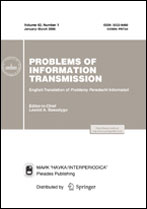|
|
Problemy Peredachi Informatsii, 2004, Volume 40, Issue 2, Pages 3–18
(Mi ppi129)
|
|
|
 |
This article is cited in 10 scientific papers (total in 10 papers)
Coding Theory
Symmetric Rank Codes
È. M. Gabidulin, N. I. Pilipchuk
Moscow Institute of Physics and Technology
Abstract:
As is well known, a finite field $\mathbb K_n=GF(q^n)$ can be described in terms of $(n\times n)$ matrices $A$ over the field $\mathbb K=GF(q)$ such that their powers $A^i$, $i=1,2,\dots,q^n-1$, correspond to all nonzero elements of the field. It is proved that, for fields $\mathbb K_n$ of characteristic 2, such a matrix $A$ can be chosen to be symmetric. Several constructions of field-representing symmetric matrices are given. These matrices $A^i$ together with the all-zero matrix can be considered as a $\mathbb K_n$-linear matrix code in the rank metric with maximum rank distance $d=n$ and maximum possible cardinality $q^n$. These codes are called symmetric rank codes. In the vector representation, such codes are maximum rank distance (MRD) linear $[n,1,n]$ codes, which allows one to use known rank-error-correcting algorithms. For symmetric codes, an algorithm of erasure symmetrization is proposed, which considerably reduces the decoding complexity as compared with standard algorithms.
It is also shown that a linear $[n,k,d=n-k+1]$ MRD code $\nu_k$ containing the above-mentioned one-dimensional symmetric code as a subcode has the following property: the corresponding transposed code is also $\mathbb K_n$-linear. Such codes have an extended capability of correcting symmetric errors and erasures.
Received: 10.04.2003
Revised: 04.03.2004
Citation:
È. M. Gabidulin, N. I. Pilipchuk, “Symmetric Rank Codes”, Probl. Peredachi Inf., 40:2 (2004), 3–18; Problems Inform. Transmission, 40:2 (2004), 103–117
Linking options:
https://www.mathnet.ru/eng/ppi129 https://www.mathnet.ru/eng/ppi/v40/i2/p3
|


|





 Contact us:
Contact us: Terms of Use
Terms of Use
 Registration to the website
Registration to the website Logotypes
Logotypes







 Citation in format
Citation in format 
